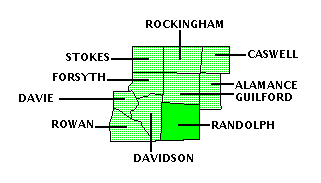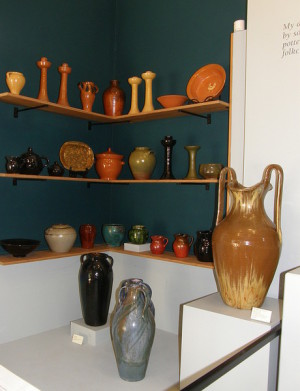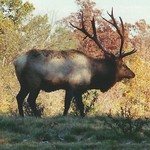RANDOLPH COUNTY
Scroll down this page or click on specific site name to view features on the following Randolph County attractions/points of interest:
North Carolina Aviation Museum, North Carolina Pottery Center, North Carolina Zoological Park, Pisgah Covered Bridge, Richard Petty Museum
Fast facts about Randolph County:
Created in 1779, the county is named for Peyton Randolph, first president of the Continental Congress.
The county seat is Asheboro, named for Samuel Ashe, a North Carolina governor. Other communities include Archdale, Franklinville, Liberty, Ramseur, Seagrove, and Whynot.
Randolph County’s land area is 787.36 square miles; the population in the 2010 census was 141,752.
It is worth noting that North Carolina’s famed pottery industry is centered in and around Seagrove; the North Carolina Zoological Park is centrally located in Randolph County, south of Asheboro.
Below: The carousel at the North Carolina Zoological Park features a colorful collection of exotic animals
South of Asheboro
Asheboro is well publicized as the home for the North Carolina Zoo. A lesser-known Asheboro attraction is the North Carolina Aviation Museum. Formerly the Peddycord Foundation for Aircraft Conservation, this non-profit organization is dedicated to the restoration and preservation of vintage aircraft. The Museum’s collection of aircraft is small, but impressive. Planes on display are privately owned, and all are still operational. As such, the Museum can boast the largest collection of flight-worthy vintage aircraft in the South. Several planes have been flown in anniversary celebrations at the Wright Brothers Memorial in Kitty Hawk.
It seems appropriate that the most historically significant aircraft on display at the Asheboro museum has a direct connection to one of the Wright Brothers. During the early 1940s, Piper manufactured a limited number of planes to be sold at auction, with proceeds going to the British Royal Air Force Benevolent Fund. Because its canopy was reminiscent of the British Spitfire, the plane was nicknamed the “Flitfire.” Only 13 of the 49 planes manufactured survive, and the Museum has the distinction of showcasing the first one built. The craft’s true historic significance, however, has to do with one of its pilots – Orville Wright flew the plane many times during 1943.
The Museum heralds itself as “Home of the B-25 ‘Carolina Girl,’” the affectionate nickname given to its 1944 Mitchell bomber. A principle component of America’s World War II air armament, the B-25 was equipped with the M-9 Norden Bombsight, one of the most highly safeguarded technological advancements of the war. Security precautions included removing these bombsights from their aircraft after missions were completed and storing them in secured facilities. Crewmen were also given specific orders to destroy the bombsight if there was any danger of its falling into enemy hands. Another WWII vintage warplane on display is the carrier-based Grumman Avenger. Armed with four 500-pound bombs, the Avengers first saw action at the battle of Midway. In 1944, George H. Bush was shot down while piloting one such Avenger, but not before scoring a direct hit on his intended target.
The majority of planes are of World War II vintage, although a few Korea and Vietnam-era aircraft are exhibited as well. The planes are displayed in two hangers, one built especially for the Museum. Cases lining the wall of this hanger showcase WWII period newspapers, clothing, ration books, war bonds, and similar signs of the time. With the emphasis on the 1940s, the big band sounds of Glenn Miller, Tommy Dorsey and Benny Goodman on the radio contribute to the Museum’s ambience. The smell of motor oil and the drone of airplanes taking off and landing at the nearby airport also give the Museum atmosphere. The Aviation Museum is located three miles south of Asheboro off NC 49. Turn onto Tot Hill Farm Road, then right onto Pilot View Road. The Museum is straight ahead, adjacent to the Asheboro Airport. The Museum is open 10-5 Monday-Saturday and 1-5 Sunday. Admission charged. Since Museum aircraft are often participating in air shows on weekends during the season (April-October), visitors are advised to call ahead to confirm operating hours. 336-625-0170
Seagrove
Travel anywhere in North Carolina and you’re almost certain to come upon someone making and selling pottery. For decades, the Tar Heel State has enjoyed a reputation as America’s pottery capital. Few would argue that the heart of NC pottery is found very near the geographic center of the state – the small town of Seagrove and its immediate surroundings. The “birthplace” of traditional NC pottery, Seagrove is thus an appropriate location for the NC Pottery Center.
As tempting as it is to start visiting individual shops immediately upon your arrival in Seagrove, you’ll benefit from a visit to the Pottery Center. The build-ing, designed by Raleigh-based architect Frank Har-mon, is intended to be in harmony with commonly seen countryside structures – barns, churches and potters’ sheds. The result is a warm and inviting facility that showcases hundreds of pottery pieces in permanent exhibits. Representative examples of pottery, photos, artifacts and memorabilia combine to illustrate the history, development and ongoing traditions of pottery-making in this area and across the state. The collection offers a tremendous variety of styles and techniques spanning centuries, from Native American to early colonial to modern pieces straight from the kiln.
Moravian settlers were skilled potters, and many of the older items on display come from Old Salem, such as a circa-1760 burgundy-colored jar made in Forsyth County by noted artisan Gottfried Aust. The collection also includes face jugs and grave markers. The Center also features temporary exhibits, sometimes showcasing a particular artist or a themed collection by different potters. The Center has its own gift shop, of course, but it is often more rewarding to visit individual area craftsmen and buy pieces directly from them. Most potters have shops within a short drive of the Center, and very often the artists will be close at hand; many times you can see them working on new pieces. Free maps available at the Center make it easy to locate potters in Seagrove and such nearby communities as Asheboro, Robbins, Eagle Sprints and the whimsically named Whynot. Though some potters are relatively new to the area, many have family roots that go back to when the area was first settled by English and German immigrants in the mid-1700s.
Originally, the potters turned out functional, lead-glazed earthenware. After learning of the toxic nature of lead in the 1820’s potters in the Piedmont began producing salt-glazed stoneware. In the state’s western counties, an alkaline glaze became popular. Until the 1920s, functionality was more important than artistry. When Jacques and Juliana Busbee of Raleigh opened a store in New York City’s Greenwich Village during the 1920s and established the Jugtown Pottery brand, the state finally started gaining its reputation for pottery. As pottery began to appeal to outsiders as collectibles, style and design started to supplant function in importance.
South of Asheboro
The North Carolina Zoological Park, located about five miles southeast of Asheboro, was the first American zoo designed from its inception with the idea of providing “natural habitats” for the animals, exhibiting them in large compounds that would resemble the habitats in which they would be found in the wild. The nation’s largest walk-through natural-habitat zoo, the NC Zoo currently has over 500 developed acres, with 900 additional acres available for future expansion.
When the North Carolina Zoo opened in 1979, it was the first state-supported zoo in the nation, and even today it has the distinction of being one of only two state zoos in the nation. Its location near Asheboro was carefully chosen to make it as central – and accessible – to all North Carolinians as possible. The Park is not only a great place for the animals that live here, but also a great venue for the visitors who come here to see them. The Zoo is nestled in the picturesque Uwharrie Mountains, and even though the hills are not high enough to truly to be called “mountains,” there’s definitely some uphill walking involved. Still, the Zoo is well designed for foot traffic and has more than five miles of paved walks. The park is divided into two main regions – North America and Africa – and trams run continuously throughout the day to help expedite movement between the two areas. Guests should allow themselves a minimum of five hours to see the entire park at a comfortable pace.
The Zoo has definitely been a work in progress. When it first opened, only the Forest Edge habitat for zebras, ostriches, and giraffes was ready. The habitats for the elephants, rhinoceroses, lions, chimpan-zees, and baboons opened the following year. By the mid-1980s, the Forest Aviary, African Pavilion, and African Plains exhibits had opened. Habitats in the North America region were several years in coming, beginning with the Sonora Desert in 1992 and ending with the Streamside exhibit in 1996. Changes and improvements have continued over the years, such as the new polar bear habitat completed in 2013.
The North American region exhibits polar bears, sea lions, and arctic foxes; alligators and otters; black bears, grizzly bears, and red wolves; and bison and elk roaming an 11-acre “prairie.” Most of the animals normally associated with the “Dark Continent” can be spotted in the Africa region: lions, chimpanzees, zebras, giraffes, gorillas, ostriches, and wart hogs have their compounds, and elephants, rhinoceroses, and antelope graze the 37-acre African Plains. Putting the size of the NC Zoo in perspective, the total acreage of many zoos in America is less than that which the North Carolina zoo uses for its African Plain exhibit alone. The African Pavilion houses crocodiles and many varieties of monkeys and cats.
Between the North American and African sections, visitors will find the Sonora Desert exhibit, an indoor recreation of America’s famous southwestern desert. In this dry climate are found roadrunners, ocelots, reptiles, and bats. The nearby Forest Aviary is filled with lush vegetation and over 140 species of exotic tropical birds and plants.
The Zoo is open every day except Christmas Day. Hours are 9-5 April through November and 9-4 December through March. Admission charged. The zoo has all the amenities you might expect – year-round restaurants, refreshment stands, and gift shops. There are also several play areas for the younger visitors and a beautiful carousel with colorful, dramatic likenesses of many of the animals found at the zoo, including many not normally found on a merry-go-round: alligators, otters, seals, and wolves, to name but a few. Large picnic areas are located outside the zoo entrances near the parking lots. 800-488-0444
South of Asheboro
In 1911, a rather ordinary pine and fieldstone bridge spanning the Little River in southwestern Randolph County was constructed for the modest price of $40. Actively used for forty-five years, the Pisgah Covered Bridge was closed to all but foot traffic in 1956, when a modern two-lane bridge was put up beside it. By the mid-1950s, the old wooden span was already only one of two covered bridges remaining in the state. In the years that followed, nature and neglect took their toll on the bridge, making it anything but a destination point for tourists. Things changed in 1998, however, when members of the community partnered with the NC Department of Transportation, the Piedmont Land Conservancy, and the Land Trust for Central North Carolina. Over $73,000 was raised to refurbish the bridge and add a family-oriented hiking trail and picnic tables. Pisgah Bridge was now an attraction, and signs along the highway proudly pointed the way to the rustic structure.
All was well until one day in August, 2003, when a heavy rainstorm – five inches of rainwater in five hours – created a flood that washed away the county landmark. Scavengers quickly went about collecting souvenirs from the iconic bridge; once word spread that the structure could be rebuilt, however, these bits and pieces were returned to a collecting point. Other parts of the bridge were salvaged from the river bank. Eventually, about 90 percent of the original material was reclaimed and used in the reconstruction. Reinforced with steel and concrete, the span was rebuilt at a cost of over $80,000 and rededicated on May 18, 2004. Pisgah Covered Bridge and its surrounding park is once again a welcoming place for those looking for a quieter place and time. Here, you can party like its 1911!
Level Cross
The accomplishments of stock car driver Richard Petty are impressive indeed: 200 career wins! 7 NASCAR Championships! A member of the inaugural class of the NASCAR Hall of Fame. The Richard Petty Museum, in the driver’s hometown of Level Cross, celebrates the stellar career of the driver whose many successes earned him the nickname, “The King.” Lots of racing memorabilia is on display, including, of course, a number of “Petty blue” # 43 Plymouths. Admission to the Museum includes a free pass to Petty’s Garage; both the museum and the garage are located next to the old Petty family home. Museum hours are 9-5 Monday through Saturday. Admission charged. 336-495-1143
Randolph County is bordered by ALAMANCE, CHATHAM (Region Four), DAVIDSON, GUILFORD, MONTGOMERY (Region Seven) and MOORE (Region Seven) counties.
Return to REGION SIX HOME PAGE.
Return to GEOGRAPHIC REGIONS HOME PAGE.






















